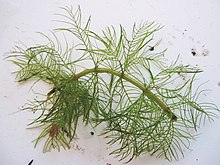Myriophyllum verticillatum
| Myriophyllum verticillatum | |
|---|---|
 |
|
| Scientific classification | |
| Kingdom: | Plantae |
| (unranked): | Angiosperms |
| (unranked): | Eudicots |
| (unranked): | Core eudicots |
| Order: | Saxifragales |
| Family: | Haloragaceae |
| Genus: | Myriophyllum |
| Species: | M. verticillatum |
| Binomial name | |
|
Myriophyllum verticillatum L. |
|
Myriophyllum verticillatum, the whorl-leaf watermilfoil or whorled water-milfoil, is a native to much of the North America, North Africa, and Eurasia. It closely resembles another native milfoil, called northern water milfoil (M. sibiricum) Whorled water milfoil is also easily confused with four types of invasive milfoils: Eurasian water milfoil (M. spicatum), Variable water-milfoil (M. heterophyllum), Parrot feather (M. aquaticum), and hybrid water milfoil (M. heterophyllum X M. laxum).
In many areas it is an invasive aquatic plant.
With the increase in water sports, the spread of many water milfoils (Haloragaceae) has increased over the years. The spread of a milfoil is not only within one area, sometimes it spreads from one area to another many miles away.
To the untrained eye, whorled water milfoil can look similar to other species.
The best way to identify whorled water milfoil (M. verticillatum) is by looking at its two different types of leaves. The first type is the submersed leave, which looks feathery and contain about 5 to 14 leaflet pairs per leaf. The whorls along the stem contain about 4 to 5 leaves, which are spaced about 1 cm apart. The other type is known as the emergent leaves. These leaves occur on the emergent spike and are pinnately lobed. From June till September whorled water milfoil produces flowers and fruits above or at the water's surface on erect spikes along the emergent leaves. The emergent leaves are typically two or more times longer than the flowers and fruits.
Another way to distinguish whorled water milfoil is to look for turions, winter buds that appear toward the end of its growing season. This milfoil is one of a few that produce turions. This characteristic can also rule out other types of water milfoil that lack turions such as Eurasian water milfoil, parrot feather, hybrid water milfoil, and low water milfoil. The turions of this milfoil look like long yellowish-green club-shaped buds with small stiff leaves attached to the submerged stem. In the spring after dormancy the small, thick, dark green turions expand and grow from the stem. As the plant develops roots and continues to grow, the larger green summer leaves are produced at the tip of the plant. Turion leaves can be seen at the base of the plant sometimes into July. In fall the turions, with some other plant material, often break away from the majority of the rooted plant and float to new areas. Those fragments can be found washing up along shorelines in late fall. The stems of the whorled water milfoil form into mats from branched and unbranched stems that grow to be 20 to 100 inches long.
...
Wikipedia
